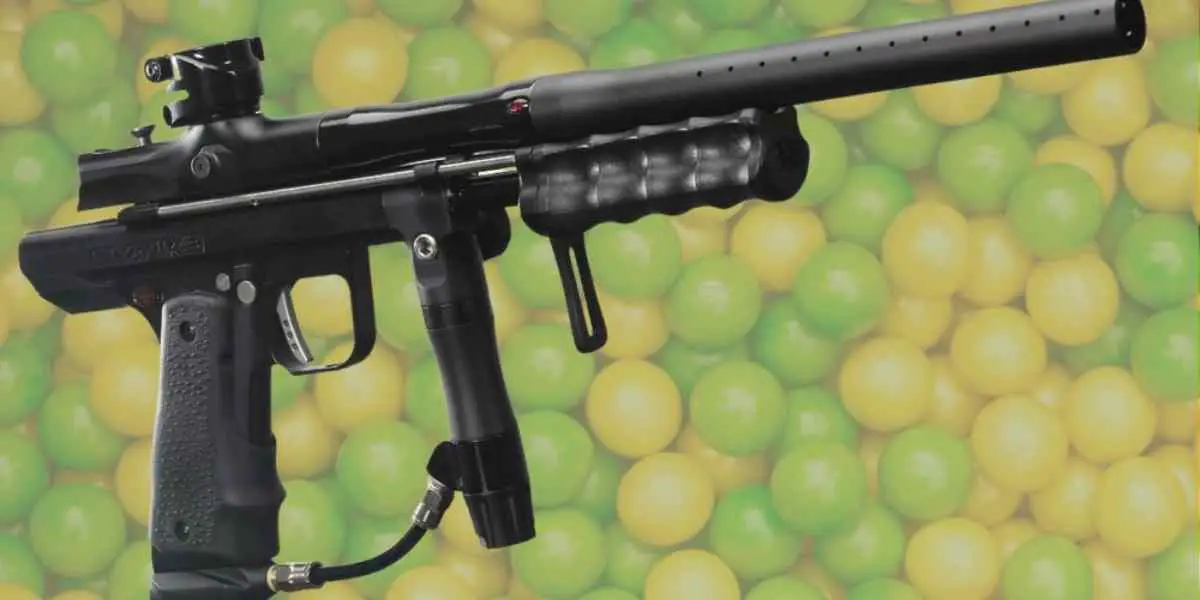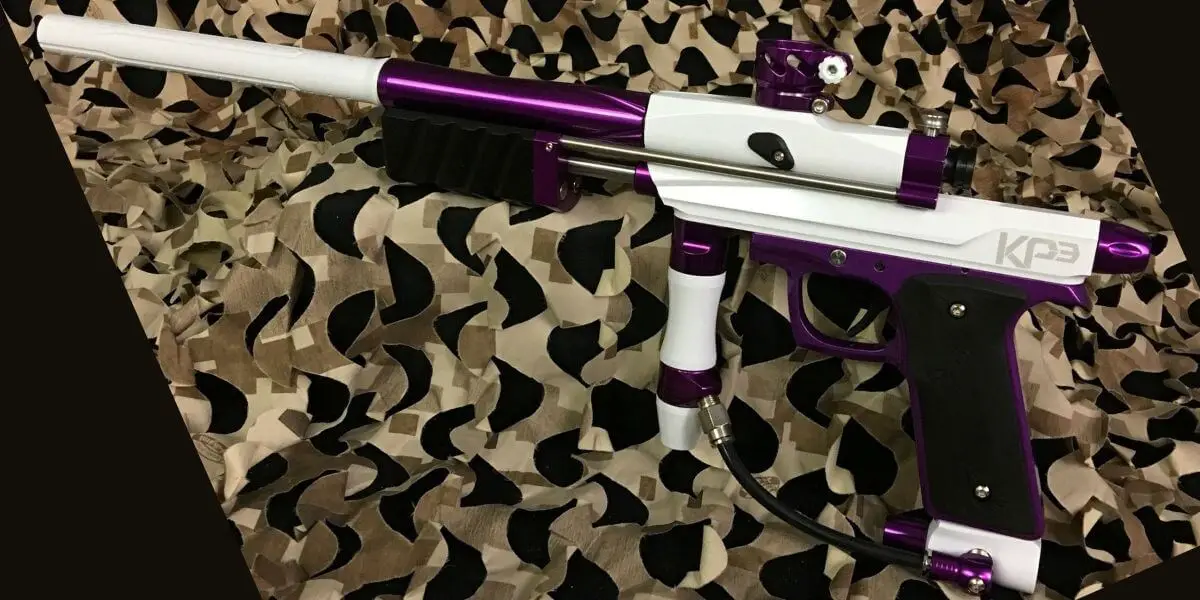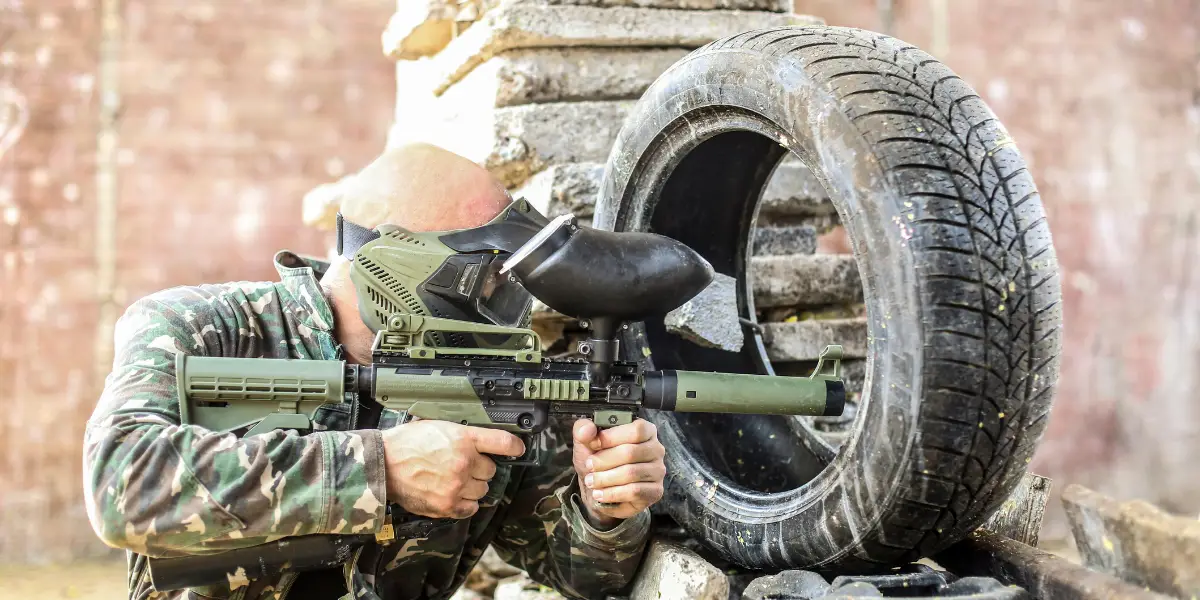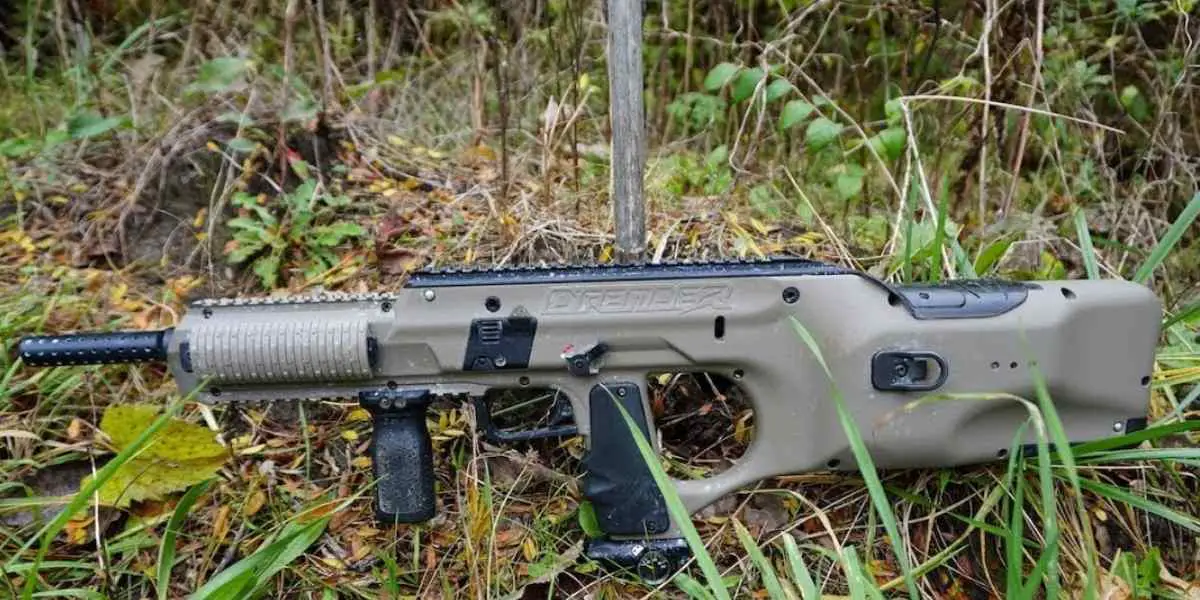
CO2 and compressed air are the two primary options for paintball payers looking to a way to fuel their markers. Both have their strengths and weaknesses... but which is better overall?
CO2 tanks are better for casual users, while veteran paintball players will probably prefer a compressed air canister.
There are some key differences between each of the paintball canister types. This article will explain each of those differences in great detail.
Beginner paintballers will find CO2 tanks the better option for a few reasons:
Veteran paintballers will prefer compressed air tanks for the following reasons:
CO2 tanks first entered the paintball scene when paintball itself entered the sports scene. This gas was the first propellant used in paintball markers, and is still used today as an alternative to compressed air.
When you fill up a CO2 tank, you aren’t filling it with liquid, though. The CO2 in your tank starts out as a liquid, and is converted into a gas when it escapes the chamber. When you pull the trigger on your paintball marker, you activate the valve in your marker that sets the on/off state of the CO2 tank. When the tank is activated, the converted gas expels the paintball from the barrel of the marker.
Compressed air tanks ‒ also called High Pressure Air (HPA) tanks ‒ came onto the paintball scene in the 1990s. They were an innovative response to the limitations offered by CO2 canisters.
In the beginning, compressed air canisters were filled with nitrogen gas. If you hear someone refer to an HPA tank as a Nitro tank or an N2 tank, that’s why. Modern compressed air tanks are now filled with regular old air ‒ just in a highly compressed format.
As far as operation goes, compressed air tanks are quite similar to CO2 tanks ‒ just without the conversion of a liquid to a gas. The pressured air pushes the piston forward, firing the paintball in the direction your marker is facing.
One of the main differences between CO2 tanks and compressed air tanks is the size. CO2 canisters are typically lighter and smaller than their compressed air counterparts. Using a smaller CO2 marker will help players move and shoot a bit more quickly than if they were carrying one that uses compressed air.
Smaller canisters don’t necessarily mean decreased performance, though. Most CO2 canisters provide at least as many shots per fill as larger compressed air canisters. And if you get a particularly high-quality tank, some CO2 tanks even hold more shots per fill than similar compressed air options.
A big issue with using compressed air is the relative lack of compressed air sources. CO2 markers can be filled at paintball shops, welding stores, fire extinguisher stores, and a number of other locations that sell CO2 products.
This wide availability is a stark contrast to compressed air sources, which can typically only be found at paintball shops. And unfortunately, you can’t use the air from tire pumps or shop compressors, as these sources only reach 180 psi, which is too low to fill a paintball tank.
Another great reason to go with a CO2 tank is how inexpensive the canisters are. If you’re playing paintball on a budget, going with a CO2 marker will enable you to own and fill multiple tanks ‒ something essential for marathon paintballing sessions. Budget players who opt for a compressed air gun may find themselves out of fuel halfway through the day.
The biggest knock against CO2 is the drop in accuracy some players experience when firing rapidly.
Here’s what happens: When you use a CO2 marker, the CO2 inside transitions from a liquid state to a gaseous state. When you fire your marker rapidly over an extended period of time, the tank pressure will drop substantially. And when the pressure drops, the temperature of the tank will also drop ‒ it’s this temperature decrease that causes liquid CO2 to move into the marker.
If enough liquid CO2 makes its way into the main part of your marker, velocity will increase to extreme levels and your shots will become inaccurate. Paintballs won’t always go where you aim them ‒ which can be the difference between a win or loss.
When you see white vapor clouds leaking from the muzzle or white “snow” (which is really dry ice) falling from the barrel, liquid CO2 has probably made its way into the marker.
Because compressed air isn’t transitioning between states of matter, it doesn’t have this accuracy issue. This is one of the main reasons many pros started using compressed air during competition.
Compressed air is not only more reliable during rapid fire situations, it’s also more tolerant of extreme cold.
If you use a CO2 marker in a cold weather situation, the chance for a weather-induced pressure drop increases exponentially. When the pressure in your CO2 tank drops below a certain amount, your market will have trouble cycling correctly. This will also affect your ability to fire consistently and accurately, so go with a compressed air gun if you’re going to be playing in colder weather.
Inconsistent accuracy isn’t the only issue with CO2. The liquid form of this molecule can damage the seals on your marker if they are exposed to it for an extended period of time. Compressed air guns don’t have this problem ‒ because there are no liquids involved, the marker cannot be damaged.
Fortunately, most paintball marker manuals will tell you whether CO2 will damage the marker or not. So check your documentation if you’re not sure ‒ it might just save from replacing the whole thing.
One of the most annoying things about using a CO2 tank is that you have to guess at how much fuel is left. Compressed air tanks have a regulator gauge that tells you exactly how much air is left in the canister, eliminating this frustrating aspect of CO2-powered paintballing.
While the relative affordability of CO2 tanks make it easy to bring enough canisters along for a whole day of paintballing, you won’t be able to top off those tanks between games. So if you only bring one canister, you’re going to be out of luck if you run out of fuel before you expected to.
Compressed air canisters can be topped off between games, making them a better option for players who don’t like lugging around a bag of replacement tanks.
Most higher end markers play better with compressed air over CO2. And some of the newest models don’t even work
If you find yourself playing more ‒ and your marker is keeping you from excelling ‒ owning a compressed air tank will make the decision to upgrade cheaper and easier.
You’ll usually pay more to fill a CO2 canister than you will to fill a compressed air canister at a paintball field. Because these semi-remote locations need to purchase and ship in CO2 from a third party vendor, they will charge much more for a CO2 refill than they will for a compressed air refill.
Because compressed air is objectively the smarter option, many professional paintball fields don’t even offer CO2 refills anymore. You’re still free to bring your own canisters, but don’t be surprised if your preferred field stops offering CO2 refills.
Whether you buy a CO2 tank or a compressed air tank, each has its own specific setup and maintenance requirements. Use these tips to properly take care of your tank, regardless of its type.
Both CO2 and compressed air tanks have a hydro date, which is the month and year the tank underwent safety testing. This date is typically located near the neck of most canisters, though it can be anywhere on the bottle’s exterior.
When you get a new tank, make a note of the hydro date. If you’re still using the tank five years after the hydro date, you should either replace the tank or get it retested.
As I mentioned earlier, finding a reliable spot to fill a compressed air tank can be difficult. If you don’t live near a paintball pro shop, you might find your paintballing opportunities limited to when you visit large paintballing centers.
One rather unique solution to this scarcity problem is to fill a scuba tank and outfit it with a Scuba Fill Station. If you have a standard scuba tank (3,000 psi), you can get a good 20 paintball tank fills out of it. Using the scuba tank method will drastically cut down on the trip you’ll need to make to the pro shop to fill your marker.
CO2 tanks receive their fuel through a valve, and must be completely drained before a refill. Compressed air tanks receive their fuel through a nipple on the side of the regulator, and can be refilled if partially full.
One additional benefit of compressed air tanks is that they don’t need to be removed from the market to be refilled. So players who play with an aggressive, rapid-fire style won't have to detach their tank to refill it after every round.
If you want a little more oomph in your compressed air paintball marker, you can upgrade from a standard 3,000 psi tank to a 4,500 psi tank.
The main difference between a 3,000 psi tank and a 4,500 psi tank is the number of shots you can fire on a single tank fill. The 4,500 psi canister can tolerate more air per cubic inch, so it will take longer to drain the tank.
The actual shot count difference varies depending on the marker, but 4,500 psi tanks will typically get 1.5x more shots per cubic inch than their 3,000 psi counterparts.
Federal law dictates that all CO2 and compressed air tanks be shipped empty. Although slightly annoying, this is a pretty smart rule ‒ shipping a bunch of pressurized containers is a disaster waiting to happen.
There are two exceptions to this rule: disposable, one-time use CO2 canisters and small 12-gram cartridges. Both of these may arrive with air in them, though they will have to be shipped via ground service.
Oil is a flammable substance, and a compressed air tank will heat up drastically when it’s being filled. To minimize the risk of fire or explosion, never place oil, grease, or any other flammable substances near the opening of your compressed air tank.
Fiber wrapped tanks are more fragile than their metal counterparts. As such, you should outfit them with a quality tank cover to prevent dings and scratches. This protection is for more than pure aesthetic purposes ‒ a damaged tank can’t be filled, and a tank that can’t be filled is useless.
The excess heat from prolonged exposure to the sun is bad for both CO2 tanks and compressed air tanks. CO2 tanks can build up so much pressure that they burst a disc, while sunlight can cause damage to the seals on a compressed air tank.
As I mentioned earlier, liquid CO2 getting into the tank marker can cause affect your accuracy. If you walk around with the muzzle down, gravity will draw liquid CO2 into the main chambers. As such, it’s a smart idea to walk around with the muzzle up, as this will keep the liquid in the tank where it belongs.
If the weather is cool at one point in the day and gets significantly hotter later, you’ll need to re-chronograph your CO2 marker. The speed of your paintballs may get faster as it gets warmer as the heat will create additional pressure in your tank. If the velocity reaches your maximum safe velocity boundary, you could be shooting paintballs hard enough to hurt someone.
If you haven’t picked up on it yet, CO2 tanks have a reliability issue. Purchasing an expansion tank can help make them more reliable, as it will catch liquid CO2 before it enters the marker. This upgrade can also help with the conversion from liquid to gas, thereby making the marker more consistent and efficient.
If you’re looking for a high-quality compressed air tank, the Ninja Compressed HPA Air Tank (available on Amazon) is an excellent option.
Pros of the Ninja Compressed HPA Air Tank:
The Empire Basics 3K Tank (available on Amazon) is a solid choice for those on a budget. While the aluminum frame doesn’t have the lightweight sturdiness of the Ninja, it’s still a great tank for the lower price point.
Pros of the Empire Basics 3K Tank:
The Empire CO2 tank (available on Amazon) is one of the best CO2 tanks on the market. If you’d like to try a CO2 tank before upgrading to compressed air, this is the best one to go with.
Pros of the Empire CO2 tank:
 Empire Paintball Sniper Pump Marker Review
Empire Paintball Sniper Pump Marker Review Azodin KP3.5 KAOS Review
Azodin KP3.5 KAOS Review Tippmann Cronus Review
Tippmann Cronus Review Empire BT DFender Review
Empire BT DFender Review